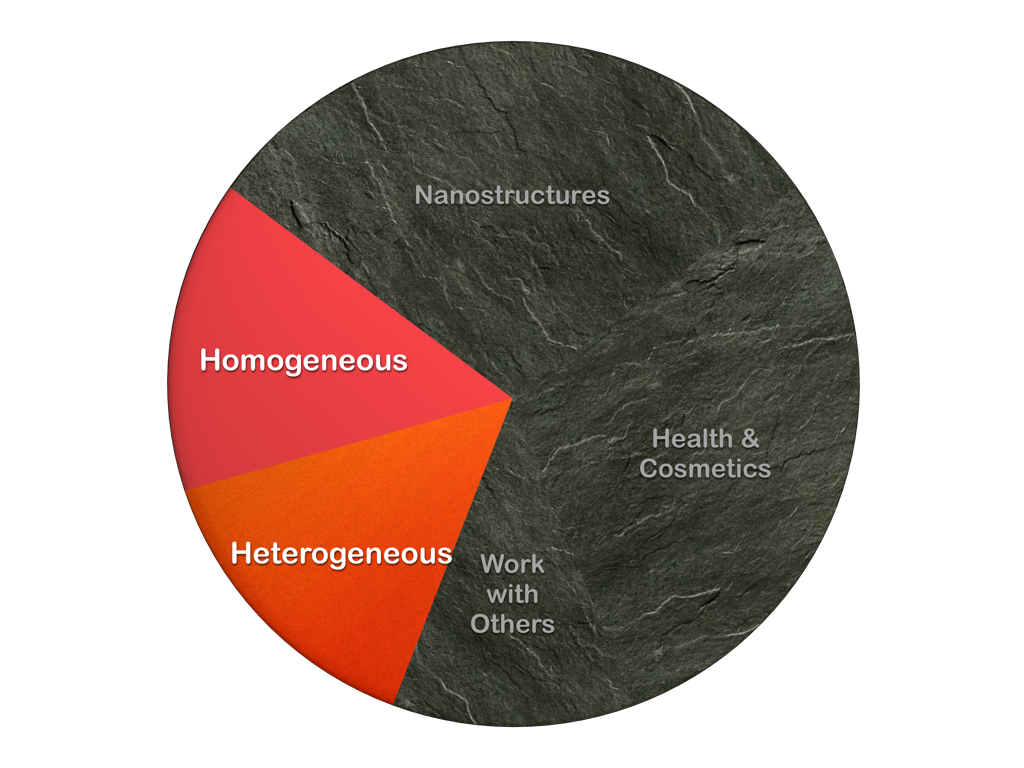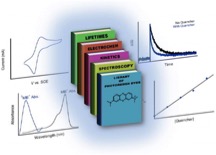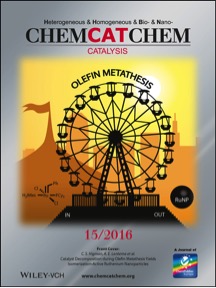Catalysis
Catalysis
Catalysis by metal nanoparticles raises the question as to whether heterogeneous catalysts may cause homogeneous catalysis through partial dissolution of the solid catalyst, or through metal ions leaching. The question is critical as unwanted homogeneous processes could offset the benefits of heterogeneous catalysis. On the other hand, formation of NPs from metal-based homogeneous catalysts should be considered as a potential contributor on the catalytic activity of otherwise “homogeneous” catalysts. By understanding the catalytic mechanism, the revalorization of materials (the utilization of noble metals such as gold as photo-catalyst, for example) that had been disregarded as useless catalysts can also be possible.

HomogeneousOur studies of homogeneous catalysis have concentrated in photoredox catalysis; a methodology that uses light, frequently visible light, as a tool in organic synthesis and takes advantage of the enhanced redox properties of excited states. Our work has benefited from our expertise and the in-house tools available for the study of photochemical mechanism and kinetics. |
HeterogeneousHeterogeneous photocatalysis has emerged as a promising technology providing both facile catalyst separation, and visible-light-induced selective organic transformations, contributing environmentally friendly and energy sustainable alternatives. Our group has increased interest in the revalorization of materials that sometimes had been disregarded as useless catalysts. We focus our studies on understanding the catalytic mechanism at the bench and the single-molecule level. |
Which one?
The traditional homogeneous vs. heterogeneous division of catalysis is rapidly fading, as more and more examples are discovered where the two types of mechanisms integrate, mix, or quite simply the type of catalyst used (homogeneous or heterogeneous) does not always reflect the type of mechanism involved. We have selected some of our publications on catalysis and simply classified them in the two traditional groups based on the type of catalyst used, whether is soluble or insoluble. The mechanistic details are pressented in each contribution.
Selected PublicationsOur group was the first one to show that amines, frequently used as sacrificial electron donors, can have a key role in the photoredox reaction. Inspired by this observation we went on to develop new methodologies that use inexpensive and non-toxic dyes as catalysts instead of the usual transition metal complexes. Work on trifluoromethylation and other key reactions led to the invention of a new actinometer and the creation of a library of useful photoredox dyes.
H. Ismaili, S.P. Pitre & J.C. Scaiano,” Active Participation of Amine-Derived Radicals in Photoredox Catalysis as Exemplified by a Reductive Cyclization”, Catal. Sci. Technol., 2013, 3, 935. S.P. Pitre, C.D. McTiernan, H. Ismaili, & J.C. Scaiano, “Mechanistic Insights and Kinetic Analysis for the Oxidative Hydroxylation of Arylboronic Acids by Visible Light Photoredox Catalysis: a Metal-Free Alternative”, J. Am. Chem. Soc., 2013, 135, 13286. S.P. Pitre, C.D. McTiernan, H. Ismaili, and J.C. Scaiano, “Metal-Free Photocatalytic Radical Trifluoromethylation Utilizing Methylene Blue and Visible Light Irradiation”,ACS Catal. 2014, 4, 2530. Pitre, S.P., C.D. McTiernan, W. Vine, R. DiPucchio, M. Grenier & J.C. Scaiano, “Visible-Light Actinometry and Intermittent Illumination as Convenient Tools to Study Ru(bpy3Cl2 Mediated Photoredox Transformations” (Nature) Scientific Reports 2015, 5, 16397. Pitre, S.P., C.D. McTiernan, & J.C. Scaiano, “A Library of Cationic Organic Dyes for Visible-Light Driven Photoredox Transformations”, ACS Omega, 2016, 1, 66-76. |
Selected PublicationsCatalysis by metal nanoparticles raises the question as to whether heterogeneous catalysts may cause homogeneous catalysis through partial dissolution of the solid catalyst, or through metal ion leaching. The question is critical as unwanted homogeneous processes could offset the benefits of heterogeneous catalysis. On the other hand, formation of NPs from metal-based homogeneous catalysts should be considered as a potential contributor on the catalytic activity of otherwise “homogeneous” catalysts. M. R. Decan, S. Impellizzeri, M. L. Marin, J. C. Scaiano “Copper nanoparticle heterogeneous catalytic 'click' cycloaddition confirmed by single-molecule spectroscopy”. Nat. Commun. 2014, 5. M. R. Decan & J. C. Scaiano, “Study of Single Catalytic Events at Copper-in-Charcoal: Localization of Click Activity Through Subdiffraction Observation of Single Catalytic Events” J. Phys. Chem. Lett. 2015, 4049. S. Impellizzeri, S. Simoncelli, G. K. Hodgson, A. E. Lanterna, C. D. McTiernan, F. M. Raymo, P. F. Aramendia & J. C. Scaiano “Two-Photon Excitation of a Plasmonic Nanoswitch Monitored by Single-Molecule Fluorescence Microscopy”, Chem. Eur. J. 2016, 22, 7281. G. K. Hodgson, S. Impellizzeri & J. C. Scaiano “Dye synthesis in the Pechmann reaction: catalytic behaviour of samarium oxide nanoparticles studied using single molecule fluorescence microscopy” Chem. Sci. 2016, 7, 1314. C.S. Higman, A.E. Lanterna, M.L. Marin, J.C. Scaiano & D.E. Fogg "Nanoparticle Formation in Metathesis Catalysis." ChemCatChem 2016, 7, 2446-2449.
|

